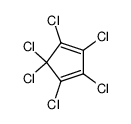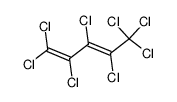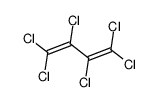1.Identification
1.1 GHS Product identifier
| Product name | Hexachlorocyclopentadiene |
|---|
1.2 Other means of identification
| Product number | - |
|---|---|
| Other names | 1,3-Cyclopentadiene, 1,2,3,4,5,5-hexachloro- |
1.3 Recommended use of the chemical and restrictions on use
| Identified uses | For industry use only. Hexachlorocyclopentadiene is the key intermediate in the manufacture of some pesticides, including heptachlor, chlordane, aldrin, dieldrin, and endrin. Hexachlorocyclopentadiene is also used in the manufacture of flame retardants and some resins and dyes. |
|---|---|
| Uses advised against | no data available |
1.4 Supplier's details
| Company | MOLBASE (Shanghai) Biotechnology Co., Ltd. |
|---|---|
| Address | Floor 4 & 5, Building 12, No. 1001 North Qinzhou Road, Xuhui District, Shanghai, China |
| Telephone | +86(21)64956998 |
| Fax | +86(21)54365166 |
1.5 Emergency phone number
| Emergency phone number | +86-400-6021-666 |
|---|---|
| Service hours | Monday to Friday, 9am-5pm (Standard time zone: UTC/GMT +8 hours). |
2.Hazard identification
2.1 Classification of the substance or mixture
Acute toxicity - Oral, Category 4
Acute toxicity - Dermal, Category 3
Skin corrosion, Category 1B
Acute toxicity - Inhalation, Category 2
Hazardous to the aquatic environment, short-term (Acute) - Category Acute 1
Hazardous to the aquatic environment, long-term (Chronic) - Category Chronic 1
2.2 GHS label elements, including precautionary statements
| Pictogram(s) |    |
|---|---|
| Signal word | Danger |
| Hazard statement(s) | H302 Harmful if swallowed H311 Toxic in contact with skin H314 Causes severe skin burns and eye damage H330 Fatal if inhaled H410 Very toxic to aquatic life with long lasting effects |
| Precautionary statement(s) | |
| Prevention | P264 Wash ... thoroughly after handling. P270 Do not eat, drink or smoke when using this product. P280 Wear protective gloves/protective clothing/eye protection/face protection. P260 Do not breathe dust/fume/gas/mist/vapours/spray. P271 Use only outdoors or in a well-ventilated area. P284 [In case of inadequate ventilation] wear respiratory protection. P273 Avoid release to the environment. |
| Response | P301+P312 IF SWALLOWED: Call a POISON CENTER/doctor/…if you feel unwell. P330 Rinse mouth. P302+P352 IF ON SKIN: Wash with plenty of water/... P312 Call a POISON CENTER/doctor/…if you feel unwell. P321 Specific treatment (see ... on this label). P361+P364 Take off immediately all contaminated clothing and wash it before reuse. P301+P330+P331 IF SWALLOWED: Rinse mouth. Do NOT induce vomiting. P303+P361+P353 IF ON SKIN (or hair): Take off immediately all contaminated clothing. Rinse skin with water [or shower]. P363 Wash contaminated clothing before reuse. P304+P340 IF INHALED: Remove person to fresh air and keep comfortable for breathing. P310 Immediately call a POISON CENTER/doctor/… P305+P351+P338 IF IN EYES: Rinse cautiously with water for several minutes. Remove contact lenses, if present and easy to do. Continue rinsing. P320 Specific treatment is urgent (see ... on this label). P391 Collect spillage. |
| Storage | P405 Store locked up. P403+P233 Store in a well-ventilated place. Keep container tightly closed. |
| Disposal | P501 Dispose of contents/container to ... |
2.3 Other hazards which do not result in classification
none
3.Composition/information on ingredients
3.1 Substances
| Chemical name | Common names and synonyms | CAS number | EC number | Concentration |
|---|---|---|---|---|
| Hexachlorocyclopentadiene | Hexachlorocyclopentadiene | 77-47-4 | none | 100% |
4.First-aid measures
4.1 Description of necessary first-aid measures
General advice
Consult a physician. Show this safety data sheet to the doctor in attendance.
If inhaled
Fresh air, rest. Half-upright position. Artificial respiration may be needed. Refer for medical attention.
In case of skin contact
Remove contaminated clothes. Rinse skin with plenty of water or shower. Refer for medical attention .
In case of eye contact
First rinse with plenty of water for several minutes (remove contact lenses if easily possible), then refer for medical attention.
If swallowed
Rinse mouth. Do NOT induce vomiting. Give one or two glasses of water to drink. Refer for medical attention .
4.2 Most important symptoms/effects, acute and delayed
This compound is very toxic and may be fatal if inhaled, swallowed, or absorbed through the skin. The probable human lethal dose is 50-500 mg/kg, or between 1 teaspoon and 1 ounce for a 150 lb. (70 kg) person. Severe exposure induces pulmonary hyperemia and edema, degenerative and necrotic changes in brain, heart and adrenal glands and necrosis of liver and kidney tubules. (EPA, 1998)
4.3 Indication of immediate medical attention and special treatment needed, if necessary
Absorption, Distribution and Excretion
Rats given 6 mg/kg hexachlorocyclopentadiene (HEX) orally excreted 33% in urine, 10% in feces in 7 days. Most excretion occurred during 1st 24 hr after dosing. Kidney retained 0.5%, liver >0.5%. Biliary excretion of only 16% with 66% still voided in the feces of bile duct cannulated rats suggested that the majority of orally consumed HEX was not absorbed. Degradation apparently occurred in the gut since little of the fecal material was of an apolar nature. The kidney, liver, ovaries and fat were the major sites of deposition of (14)C-HEX equivalents. In rats, the kidney contained the highest levels of residues, whereas in mice the residues in the liver exceeded those in the kidney. Other than this difference, the fate of HEX in rats and mice, both male and female, was quite similar and in each case the tissue residues reached a plateau after about two weeks on the HEX-containing diets.[Mehendale HM; Environ Health Perspect 21: 275-78 (1977)] Full text: PMC1475343
5.Fire-fighting measures
5.1 Extinguishing media
Suitable extinguishing media
If material involved in fire: Extinguish fire using agent suitable for type of surrounding fire (material itself does not burn or burns with difficulty). Use water spray to knock-down vapors.
5.2 Specific hazards arising from the chemical
Toxic hydrogen chloride, chlorine, and phosgene gases may form in fires. In presence of moisture, will corrode iron and other materials; flammable and explosive hydrogen gas may collect in enclosed space. Will corrode iron and other metals in the presence of moisture. Reacts slowly with water to form hydrochloric acid; however, the reaction is not hazardous. Hazardous polymerization may not occur. (EPA, 1998)
5.3 Special protective actions for fire-fighters
Wear self-contained breathing apparatus for firefighting if necessary.
6.Accidental release measures
6.1 Personal precautions, protective equipment and emergency procedures
Use personal protective equipment. Avoid dust formation. Avoid breathing vapours, mist or gas. Ensure adequate ventilation. Evacuate personnel to safe areas. Avoid breathing dust. For personal protection see section 8.
6.2 Environmental precautions
Personal protection: chemical protection suit including self-contained breathing apparatus. Do NOT let this chemical enter the environment. Collect leaking and spilled liquid in sealable plastic containers as far as possible. Absorb remaining liquid in sand or inert absorbent. Then store and dispose of according to local regulations.
6.3 Methods and materials for containment and cleaning up
Environmental considerations. Land spill: Dig a pit, pond, lagoon, holding area to contain liquid or solid material. /SRP: If time permits, pits, ponds, lagoons, soak holes, or holding areas should be sealed with an impermeable flexible membrane liner./ Cover solids with a plastic sheet to prevent dissolving in rain or fire fighting water. Absorb bulk liquid with fly ash or cement powder.
7.Handling and storage
7.1 Precautions for safe handling
Avoid contact with skin and eyes. Avoid formation of dust and aerosols. Avoid exposure - obtain special instructions before use.Provide appropriate exhaust ventilation at places where dust is formed. For precautions see section 2.2.
7.2 Conditions for safe storage, including any incompatibilities
Store in an area without drain or sewer access. Dry. Well closed. Ventilation along the floor.
8.Exposure controls/personal protection
8.1 Control parameters
Occupational Exposure limit values
Recommended Exposure Limit: 10 Hr Time-Weighted Avg: 0.01 ppm (0.1 mg/cu m).
Biological limit values
no data available
8.2 Appropriate engineering controls
Handle in accordance with good industrial hygiene and safety practice. Wash hands before breaks and at the end of workday.
8.3 Individual protection measures, such as personal protective equipment (PPE)
Eye/face protection
Safety glasses with side-shields conforming to EN166. Use equipment for eye protection tested and approved under appropriate government standards such as NIOSH (US) or EN 166(EU).
Skin protection
Wear impervious clothing. The type of protective equipment must be selected according to the concentration and amount of the dangerous substance at the specific workplace. Handle with gloves. Gloves must be inspected prior to use. Use proper glove removal technique(without touching glove's outer surface) to avoid skin contact with this product. Dispose of contaminated gloves after use in accordance with applicable laws and good laboratory practices. Wash and dry hands. The selected protective gloves have to satisfy the specifications of EU Directive 89/686/EEC and the standard EN 374 derived from it.
Respiratory protection
Wear dust mask when handling large quantities.
Thermal hazards
no data available
9.Physical and chemical properties
| Physical state | clear to light yellow liquid |
|---|---|
| Colour | Dense, oily liquid |
| Odour | Pungent, unpleasant odor. |
| Melting point/ freezing point | -10ºC |
| Boiling point or initial boiling point and boiling range | 239ºC |
| Flammability | Noncombustible LiquidNot combustible. Gives off irritating or toxic fumes (or gases) in a fire. |
| Lower and upper explosion limit / flammability limit | no data available |
| Flash point | 150ºC |
| Auto-ignition temperature | no data available |
| Decomposition temperature | no data available |
| pH | no data available |
| Kinematic viscosity | no data available |
| Solubility | less than 0.1 mg/mL at 21.5°C |
| Partition coefficient n-octanol/water (log value) | log Kow= 5.04 |
| Vapour pressure | 0.13 psi ( 20 °C) |
| Density and/or relative density | 1.702 |
| Relative vapour density | 9.4 (EPA, 1998) (Relative to Air) |
| Particle characteristics | no data available |
10.Stability and reactivity
10.1 Reactivity
no data available
10.2 Chemical stability
Stable under recommended storage conditions.
10.3 Possibility of hazardous reactions
NonflammableThe vapour is heavier than air.HEXACHLOROCYCLOPENTADIENE is incompatible with strong oxidizing and reducing agents. Also incompatible with many amines, nitrides, azo/diazo compounds, alkali metals (sodium), and epoxides.
10.4 Conditions to avoid
no data available
10.5 Incompatible materials
Reacts slowly with water to form hydrochloric acid.
10.6 Hazardous decomposition products
When heated to decomposition it emits toxic fumes of /hydrogen chloride/.
11.Toxicological information
Acute toxicity
- Oral: LD50 Albino Rat oral 300-630 mg/kg
- Inhalation: LC50 Rat (Sprague-Dawley, young adult male) inhalation 18.1 mg/cu m/4 hr
- Dermal: no data available
Skin corrosion/irritation
no data available
Serious eye damage/irritation
no data available
Respiratory or skin sensitization
no data available
Germ cell mutagenicity
no data available
Carcinogenicity
Cancer Classification: Group D Not Classifiable as to Human Carcinogenicity
Reproductive toxicity
No information is available regarding the reproductive or developmental effects of hexachlorocyclopentadiene in humans. Animal studies have not reported birth defects from exposure to hexachlorocyclopentadiene by gavage (placing the chemical experimentally in the stomach), and no information is available regarding reproductive or developmental effects from inhalation exposure. (-)
STOT-single exposure
no data available
STOT-repeated exposure
no data available
Aspiration hazard
no data available
12.Ecological information
12.1 Toxicity
- Toxicity to fish: LC50 Pimephales promelas (Fathead minnow, early juvenile) 6.7 ug/L/30 days; flow-through
- Toxicity to daphnia and other aquatic invertebrates: LC50 Daphnia magna 93 ug/L/24 hr (95% confidence interval: 78.9-109.6 ug/L); 52 ug/L/48 hr (95% confidence interval: 44.8-60.9 ug/L); static, 17°C, soft water /from table
- Toxicity to algae: no data available
- Toxicity to microorganisms: no data available
12.2 Persistence and degradability
In a static-screening study (BOD dilution water containing nutrient broth, settled domestic wastewater as inoculum, initial hexachlorocyclopentadiene concn 5 and 10 mg/l, during a 7 day incubation period in the dark) 100% loss of hexachlorocyclopentadiene was observed(1). Based on hydrolytic half-life data for this compound, hydrolysis alone does not necessarily account for the 100% observed loss of hexachlorocyclopentadiene. Volatilization was reported to be insignificant. Thus, some of the observed loss may have been due to biodegradation(SRC). Hexachlorocyclopentadiene has been found to degrade more quickly in nonsterile soils than sterile soils, suggesting that degradation was partially due to biodegradation(2).
12.3 Bioaccumulative potential
Bioconcentration factor of hexachlorocyclopentadiene in a laboratory model ecosystem were: alga (Edogonium) 341; snail (Physa) 929; mosquito (Culex) 1634; and fish (Gambusia) 448(1). BCFs in other aquatic species were: green alga (Chlorella fusca) 1090(2); fathead minnow (Pimephales promelas) <11(3) and 29(4); goldfish (Carassius auratus) 100-323(5), golden orfe (Leuciscus idus) 1230(6). The steady-state BCF value for fingerling goldfish exposed to 4 and 5 ppb of hexachlorocyclopentadiene was 1354 in a renewable freshwater system, and the BCF was 323 in a static system(7). Based on a classification scheme(8), these data indicate that bioconcentration in aquatic organisms is very high(SRC).
12.4 Mobility in soil
The attenuation mechanisms & capacity of selected clay minerals and soils for hexachlorocyclopentadiene (C-56) adsorption, a chemical model to predict C-56 migration through soil materials, & the major degradation products of C-56 in the environment were investigated. C-56 was readily adsorbed by soil materials; the adsorption capacity of C-56 was highly correlated with the total organic carbon content. Adsorbed C-56 remained immobile in the earth materials when leached with water, landfill leachates, and caustic soda brine solutions, but was highly mobile when leached with organic solvents.
12.5 Other adverse effects
no data available
13.Disposal considerations
13.1 Disposal methods
Product
The material can be disposed of by removal to a licensed chemical destruction plant or by controlled incineration with flue gas scrubbing. Do not contaminate water, foodstuffs, feed or seed by storage or disposal. Do not discharge to sewer systems.
Contaminated packaging
Containers can be triply rinsed (or equivalent) and offered for recycling or reconditioning. Alternatively, the packaging can be punctured to make it unusable for other purposes and then be disposed of in a sanitary landfill. Controlled incineration with flue gas scrubbing is possible for combustible packaging materials.
14.Transport information
14.1 UN Number
| ADR/RID: UN2646 | IMDG: UN2646 | IATA: UN2646 |
14.2 UN Proper Shipping Name
| ADR/RID: HEXACHLOROCYCLO- PENTADIENE |
| IMDG: HEXACHLOROCYCLO- PENTADIENE |
| IATA: HEXACHLOROCYCLO- PENTADIENE |
14.3 Transport hazard class(es)
| ADR/RID: 6.1 | IMDG: 6.1 | IATA: 6.1 |
14.4 Packing group, if applicable
| ADR/RID: I | IMDG: I | IATA: I |
14.5 Environmental hazards
| ADR/RID: yes | IMDG: yes | IATA: yes |
14.6 Special precautions for user
no data available
14.7 Transport in bulk according to Annex II of MARPOL 73/78 and the IBC Code
no data available
15.Regulatory information
15.1 Safety, health and environmental regulations specific for the product in question
| Chemical name | Common names and synonyms | CAS number | EC number |
|---|---|---|---|
| Hexachlorocyclopentadiene | Hexachlorocyclopentadiene | 77-47-4 | none |
| European Inventory of Existing Commercial Chemical Substances (EINECS) | Listed. | ||
| EC Inventory | Listed. | ||
| United States Toxic Substances Control Act (TSCA) Inventory | Listed. | ||
| China Catalog of Hazardous chemicals 2015 | Listed. | ||
| New Zealand Inventory of Chemicals (NZIoC) | Listed. | ||
| Philippines Inventory of Chemicals and Chemical Substances (PICCS) | Listed. | ||
| Vietnam National Chemical Inventory | Not Listed. | ||
| Chinese Chemical Inventory of Existing Chemical Substances (China IECSC) | Listed. | ||
16.Other information
Information on revision
| Creation Date | Aug 17, 2017 |
|---|---|
| Revision Date | Aug 17, 2017 |
Abbreviations and acronyms
- CAS: Chemical Abstracts Service
- ADR: European Agreement concerning the International Carriage of Dangerous Goods by Road
- RID: Regulation concerning the International Carriage of Dangerous Goods by Rail
- IMDG: International Maritime Dangerous Goods
- IATA: International Air Transportation Association
- TWA: Time Weighted Average
- STEL: Short term exposure limit
- LC50: Lethal Concentration 50%
- LD50: Lethal Dose 50%
- EC50: Effective Concentration 50%
References
- IPCS - The International Chemical Safety Cards (ICSC), website: http://www.ilo.org/dyn/icsc/showcard.home
- HSDB - Hazardous Substances Data Bank, website: https://toxnet.nlm.nih.gov/newtoxnet/hsdb.htm
- IARC - International Agency for Research on Cancer, website: http://www.iarc.fr/
- eChemPortal - The Global Portal to Information on Chemical Substances by OECD, website: http://www.echemportal.org/echemportal/index?pageID=0&request_locale=en
- CAMEO Chemicals, website: http://cameochemicals.noaa.gov/search/simple
- ChemIDplus, website: http://chem.sis.nlm.nih.gov/chemidplus/chemidlite.jsp
- ERG - Emergency Response Guidebook by U.S. Department of Transportation, website: http://www.phmsa.dot.gov/hazmat/library/erg
- Germany GESTIS-database on hazard substance, website: http://www.dguv.de/ifa/gestis/gestis-stoffdatenbank/index-2.jsp
- ECHA - European Chemicals Agency, website: https://echa.europa.eu/
















